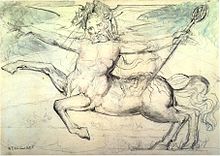Cacus


In Roman mythology, Cacus was a gigantic, murderous robber who, as the son of Vulcanus and brother of Caca, knew how to spit fire and the gate of his cave dwelling on the slope of the Aventine , which was later incorporated into the walls of Rome , with skulls and bones decorated his victims. In Rome there was still an Atrium Caci and the Scalae Caci , which led from the Palatine Hill to the Forum Boarium .
myth
When Hercules drove the cattle of Geryon through Italy after his tenth deed , he stopped in Latium near Cacus' cave, which this giant used to steal two (or four) cattle. To prevent Hercules from convicting him of a thief, he pulled the cattle backwards by the tail into its cave. The roar of a cow, however, betrayed the robber who holed up in his dwelling from the angry Hercules. Their gate was solid, but the roof of the cave could be torn off and Hercules strangled the Cacus after a long and terrible fight or killed the monster with his huge club. According to another version, Caca , the giant's sister, fell in love with Hercules and betrayed her brother for the price of his love in return.
To commemorate this act of liberation, Hercules is said to have erected the Ara Maxima , the giant altar on the Forum Boarium, the cattle market in Rome, between the Circus Maximus and the Tiber, and a sacrificial service was founded by Euandros , the then ruler of the site of what would later become Rome .
Part of the background to the myth is that the historian Gnaeus Gellius reports a fight between Hercules and a presumably Etrurian military leader Cacus, with the military leader not showing any monstrous features. Then there is the strange constellation with Caca, the sister of Cacus, of whom there is said to have been a cult provided by vestals . In addition there is evidence of an Etrurian seer named Cacu . All this suggests an old (Etrurian) pair of gods. The similarity of the name with the Greek Kakos ( κακός “bad”, “evil”) could have been the impetus for the transformation of the Cacus into a murderous monster, its conquest by Hercules and thus the victory of law well into the political-poetic program the poet of the Augustan period fit.
reception
The monster Cacus found even in death no rest, but was of Dante busy in the inferno to torture the thieves, including Vanni Fucci, the illegitimate son of Fuccio de 'Lazzari. He was guilty of a particularly shameful theft: Not enough that he stole the reliquary of San Jacopo from the Cathedral of Pistoia in 1293, he also allowed an innocent man to be arrested and almost executed in his place.
A drawing of the monster by William Blake shows Cacus according Dante description as a centaur with Thyrsos , which on its head a fire breathing dragon carries.
The cork near Eschweiler is probably named after Cacus. In addition, the myth was transplanted to the Eifel, where, as a local legend, it provided the basis for the naming of a Kakus cave in Dreimühlen near Mechernich in the Euskirchen district .
swell
- Virgil , Aeneid 8,190-279
- Titus Livius , Ab urbe condita 1,7,3-15
- Properz 4.9
- Ovid , Fasti 1,543-586
literature
- Javier Arce: Cacus . In: Lexicon Iconographicum Mythologiae Classicae (LIMC). Volume III, Zurich / Munich 1986, pp. 177-178.
- Pierre Commelin: Mythology grecque et romaíne . Ed. Fernand Nathan 2003, ISBN 2-09-191284-0 .
- Werner Eisenhut : Cacus, Caca. In: The Little Pauly (KlP). Volume 1, Stuttgart 1964, Col. 983.
- Fritz Graf : Cacus. In: The New Pauly (DNP). Volume 2, Metzler, Stuttgart 1997, ISBN 3-476-01472-X , Sp. 879 f.
- Rudolf Peter: Hercules . In: Wilhelm Heinrich Roscher (Hrsg.): Detailed lexicon of Greek and Roman mythology . Volume 1, 2, Leipzig 1890, Col. 2270-2290 ( digitized version ).
- Werner Schubert: On the saga of Hercules and Cacus in Virgil (Aen. 8,184-279) and Ovid (Fast. I, 543-586). In: Journal of Ancient Civilizations . Volume 6, 1991, pp. 37-60.
- Jocelyn Penny Small: Cacus and Marsyas in Etrusco-Roman legend. Princeton monographs in art and archeology 44. Princeton University Press, Princeton (NJ) 1982.
- Dana Ferrin Sutton: The Greek Origins of the Cacus Myth. In: The Classical Quarterly. Volume 27, 1977, pp. 391-393.
Web links
Individual evidence
- ↑ Ovid, Fasti 1,553-554
- ↑ Ovid, Fasti 1,554
- ↑ Virgil, Aeneid 8.259 to 261
- ↑ Ovid, Fasti 1,575-576
- ↑ Gnaeus Gellius fr. 9 Peter
- ↑ Lactantius Divinae institutiones 1,20,36; Maurus Servius Honoratius Commentary on the Aeneid 8,190
- ↑ Small: Cacus and Marsyas 1982. See also Graf: Cacus in DNP
- ↑ Dante, Divina Comedia , Inferno, Canto XXV, 12-33
